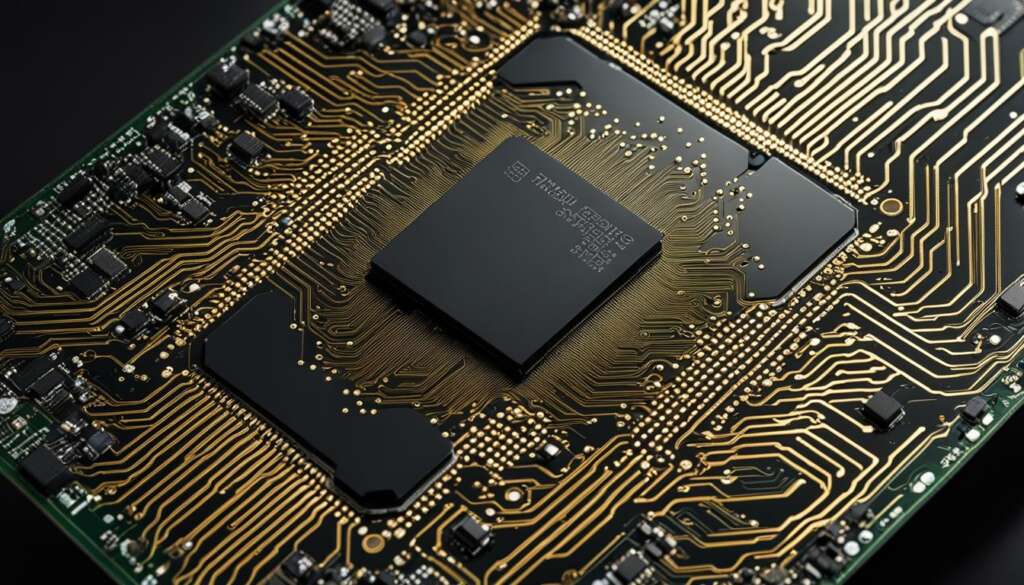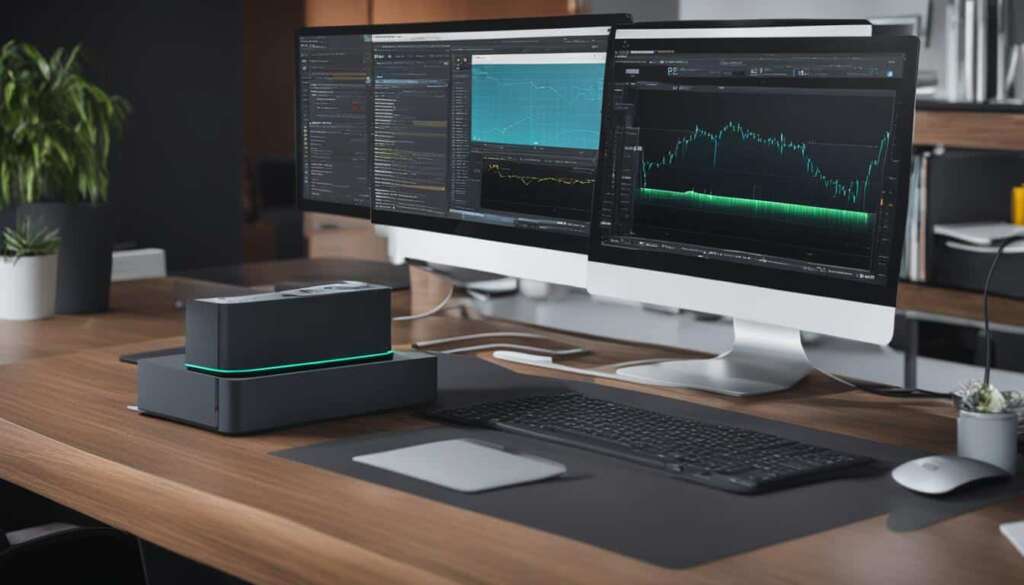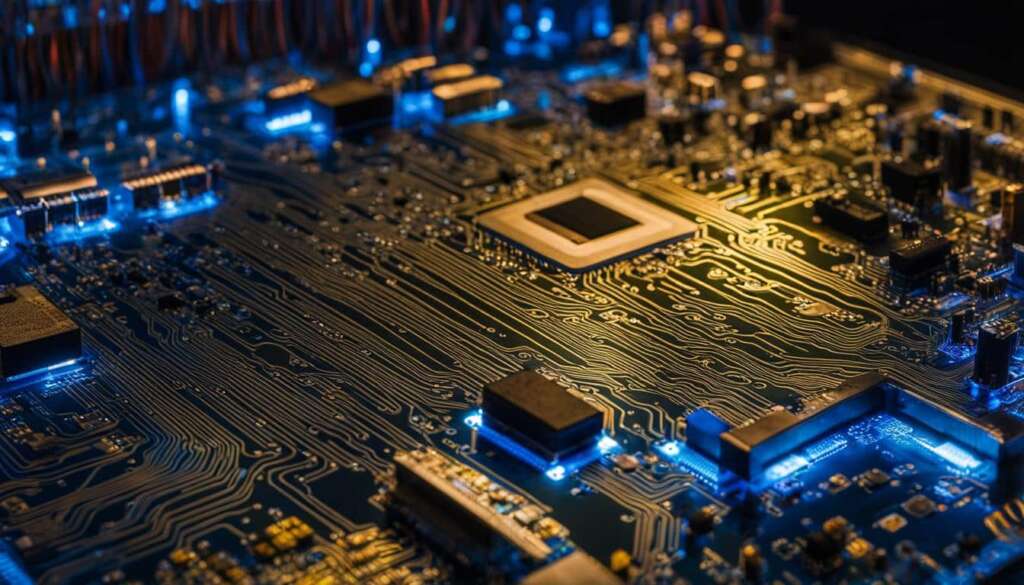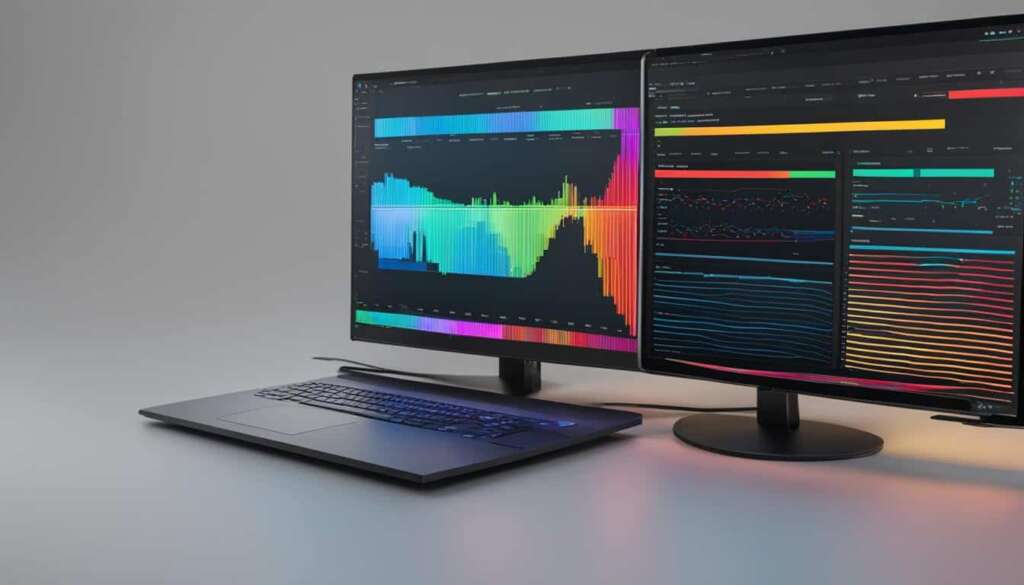Table of Contents
Welcome to our latest article, where we explore the advantages of edge computing for small businesses. In today’s digital age, distributed computing has become essential for efficient and real-time data processing. Edge computing, a decentralized architecture that processes workloads closer to their access location, offers numerous benefits for small businesses.
With the rise of IoT devices and the need for latency optimization, edge computing has emerged as a game-changer. By leveraging edge devices and edge networks, small businesses can achieve faster performance and reduced bandwidth usage. This results in improved real-time data processing, enabling businesses to make decisions swiftly and effectively.
Moreover, edge computing enhances security by managing sensitive data locally, reducing the risk of data breaches and unauthorized access. This decentralized approach empowers small businesses to protect their valuable information while optimizing costs. In fact, edge computing can lead to significant cost savings by minimizing the amount of data that needs to be processed in the cloud or centralized location.
As the worldwide market for edge computing continues to grow, projected to reach $22.5 billion by 2024, small businesses need to embrace this innovative technology to stay competitive in their respective industries. By adopting edge computing, businesses can unlock the potential of real-time data processing, latency optimization, and edge analytics, ultimately enhancing their overall efficiency and competitiveness.
What is Edge Computing?
Edge computing is a revolutionary distributed computing model that brings processing power and data storage closer to the source, enabling faster and more efficient performance. It involves utilizing edge devices, such as IoT sensors, local servers, and end-user devices, to process workloads closer to their access location. This decentralized architecture reduces latency, optimizes bandwidth usage, and enhances overall system efficiency.
With edge computing, businesses can achieve real-time data processing, enabling faster response times and improved decision-making. By processing data closer to the edge, companies can minimize the need for data transmission to centralized locations, reducing the reliance on cloud computing and optimizing costs.
Edge computing is gaining popularity due to its ability to provide faster and easier access to information. It enables businesses to unlock the full potential of IoT devices by harnessing their real-time data and processing capabilities. This paradigm shift in computing is transforming the way small businesses operate, enabling them to stay competitive in an increasingly connected world.
Benefits of Edge Computing for Small Businesses
Edge computing offers several significant benefits for small businesses. It enables real-time data processing without impacting performance by putting data closer to the devices using it. This proximity reduces latency and allows for faster access to information, improving overall operational efficiency. By processing data closer to the edge, businesses can also reduce the amount of data that needs to be processed in the cloud, leading to cost optimization.
One of the key advantages of edge computing is enhanced security. By managing sensitive data locally, edge computing reduces the risk of data breaches and unauthorized access. This decentralized approach adds an extra layer of protection and gives businesses more control over their data. As cybersecurity threats continue to evolve, ensuring the security of sensitive information is crucial for small businesses to maintain trust and comply with regulations.
“Edge computing enables small businesses to achieve real-time data processing and reduced latency, resulting in improved operational efficiency and better customer experiences.”
Furthermore, edge computing is a cost-effective solution. By reducing the amount of data processed and stored in the cloud, businesses can minimize their operational costs. Edge computing allows for processing only the necessary data, sending valuable information to the cloud for further analysis. This optimization of data processing and storage helps small businesses allocate their resources more effectively and achieve cost savings.
| Benefits of Edge Computing for Small Businesses |
|---|
| Real-time data processing |
| Reduced latency |
| Enhanced security |
| Cost optimization |
In summary, edge computing offers small businesses a range of benefits, including real-time data processing, reduced latency, enhanced security, and cost optimization. By adopting this decentralized approach, businesses can leverage the power of edge devices to improve operational efficiency, protect sensitive information, and reduce costs. As the business landscape becomes increasingly competitive and data-driven, edge computing presents an opportunity for small businesses to stay ahead and thrive in their respective industries.
Real-World Examples of Edge Computing Success
One notable example of successful edge computing implementation can be found in the City of London, a bustling financial hub. The city implemented an edge computing architecture that empowered 70% of its personnel to work remotely using mobile devices. This innovative infrastructure enabled greater productivity and efficiency in various sectors, with features such as mobile apps, video calls, and digital stock control systems. By leveraging edge computing, the City of London was able to provide real-time access to critical information, improving decision-making and enabling seamless remote work capabilities.
Another industry that has benefited from edge computing is the healthcare sector. With the integration of edge devices, healthcare providers can enhance device performance and efficiently manage patient data. Edge computing facilitates real-time data processing and analysis, improving the quality of patient care and enabling faster diagnosis and treatment. By leveraging the power of edge computing, healthcare professionals can access critical patient information accurately and quickly, enhancing overall healthcare outcomes.
“Edge computing allows us to bring advanced technologies closer to our clients, ensuring faster and seamless access to critical information, which is particularly important when it comes to financial transactions and decisions.”
Furthermore, the adoption of edge computing has significantly transformed remote work technology infrastructure across various industries. Businesses worldwide have realized the benefits of implementing edge computing solutions to enable their employees to work efficiently and securely from anywhere. By leveraging edge computing, organizations can provide their employees with real-time access to relevant data, applications, and collaboration tools. This allows for increased productivity, improved decision-making, and enhanced customer service.

Edge Computing and the Cloud
Edge computing and cloud computing can work together in a symbiotic relationship, creating a balanced and efficient technology business model. Cloud architects, certified in platforms like Microsoft Azure and Amazon Web Services (AWS), are increasingly deploying edge devices to optimize operations. The combination of cloud processing power and the rapid response of edge devices can enhance efficiency and deliver real-time results. This integration allows businesses to leverage the benefits of both edge computing and cloud computing, resulting in improved performance and streamlined processes.
In the world of data analytics, edge computing complements cloud computing by introducing higher levels of intelligence at the edge, enabling faster and more accurate analysis. By processing data closer to the source, edge computing reduces latency and improves operational efficiency. It also enhances security by isolating devices and reducing bandwidth usage. Edge computing enables businesses to process data at the edge, eliminating the need for centralized processing and reducing the potential risks associated with transmitting sensitive data.
“Edge computing and cloud computing can work together to create a balanced and efficient technology business model.”
With the growth of IoT devices and the increasing need for real-time data processing, the combination of edge computing and cloud computing becomes even more crucial. Edge devices can collect and analyze data locally, sending only relevant information to the cloud for further processing and storage. This approach reduces bandwidth requirements, optimizes costs, and enhances the overall performance of small businesses. By leveraging the power of edge computing and cloud computing, small businesses can stay ahead in today’s competitive market.
| Edge Computing | Cloud Computing |
|---|---|
| Processing data closer to the source | Processing data in centralized servers |
| Reduced latency | High computing power |
| Enhanced security | Scalability and storage capacity |
| Real-time data processing | Efficient data storage and analysis |
| Optimized costs | Flexibility and accessibility |
Overall, the combination of edge computing and cloud computing offers small businesses an efficient and scalable solution to meet their technological needs. By leveraging the strengths of both technologies, businesses can enhance operational efficiency, improve data analysis, and achieve a competitive edge in their respective industries.
The Impact of 5G on Edge Computing
5G technology plays a crucial role in the success of edge computing. With its faster wireless connectivity, reduced latency, and increased speed, 5G enables edge computing to reach new heights of performance and efficiency. By placing computational functions closer to the data source, 5G empowers edge computing to deliver improved reliability and higher processing speeds.
One of the key benefits of 5G in the context of edge computing is reduced latency. With 5G’s ultra-low latency, data can be processed and analyzed in real-time, enabling businesses to make faster, more informed decisions. This is particularly important in industries that require immediate responses, such as autonomous vehicles, robotics, and telemedicine.
Moreover, 5G enhances the reliability of edge computing systems. By leveraging the advanced network capabilities of 5G, businesses can ensure seamless connectivity and minimize disruptions. This is crucial for applications that demand uninterrupted connectivity, such as critical infrastructure monitoring and emergency response systems.
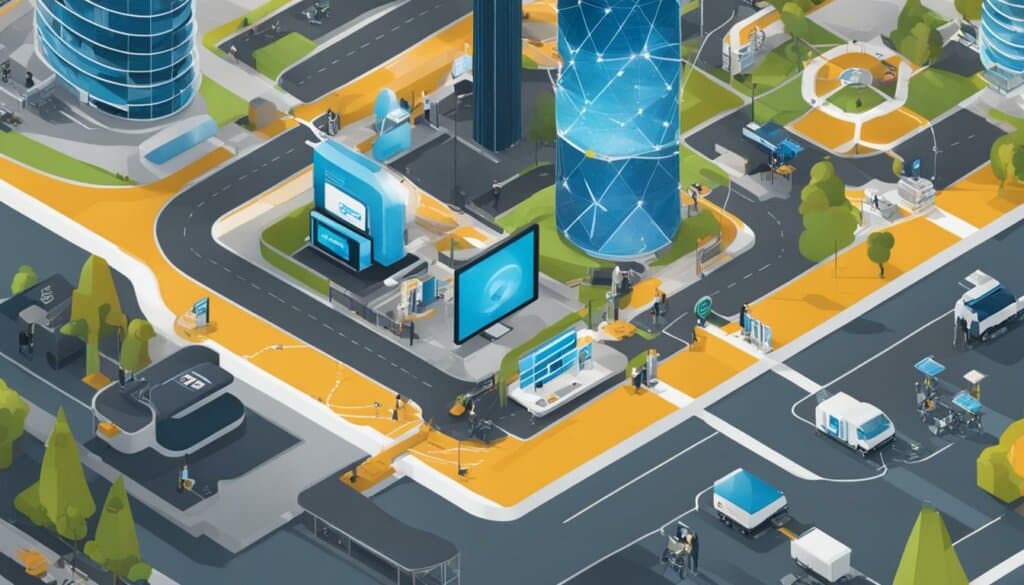
With its improved wireless connectivity, reduced latency, increased speed, and improved reliability, 5G technology significantly strengthens the capabilities of edge computing. It opens up new possibilities for small businesses to optimize their operations, enhance user experiences, and gain a competitive edge in their respective industries.
Edge Computing Use Cases in Different Industries
Edge computing is revolutionizing various industries, offering innovative solutions that improve efficiency, enhance user experiences, and optimize operations. Let’s explore how edge computing is transforming different sectors:
1. Healthcare
In the healthcare industry, edge computing is proving to be a game-changer. It enables real-time data analysis, remote monitoring of patients, and efficient management of medical devices. By processing data at the edge, healthcare professionals can access critical patient information instantly, enabling faster diagnosis and treatment decisions. Edge computing also enhances the security of sensitive medical data, improving patient privacy and compliance with regulatory requirements.
2. Retail
Retailers are leveraging edge computing to enhance customer experiences and streamline store operations. With edge analytics, retailers can gain valuable insights into customer behavior, enabling personalized marketing campaigns and real-time inventory management. This technology enables faster checkout processes, interactive displays, and improved stock control. By processing data at the edge, retail stores can offer seamless online and offline shopping experiences.
3. Manufacturing
In the manufacturing industry, edge computing is transforming operations by enabling predictive maintenance and quality control. By analyzing data from IoT sensors and machines in real-time, manufacturers can identify potential equipment failures, minimize downtime, and optimize maintenance schedules. Edge computing also facilitates real-time quality control, ensuring product consistency and reducing defects. This technology enhances overall operational efficiency, reduces costs, and improves productivity in manufacturing processes.
4. Agriculture
Edge computing is revolutionizing the agriculture industry by enabling precision farming and efficient crop monitoring. By leveraging data from sensors installed in fields, farmers can make data-driven decisions regarding irrigation, fertilization, and pest control. Real-time analysis of environmental conditions and crop health allows farmers to optimize resource usage, increase yield, and reduce waste. This technology empowers farmers to make informed decisions, leading to sustainable and efficient agricultural practices.
5. Automotive
The automotive industry is embracing edge computing to enhance safety, infotainment systems, and autonomous driving features. By leveraging edge analytics, vehicles can process data in real-time, enabling proactive safety measures such as collision avoidance systems and driver assistance technologies. Edge computing also enables personalized in-car experiences, such as personalized entertainment, navigation, and communication services. With the evolution of connected and autonomous vehicles, edge computing is crucial in processing and analyzing vast amounts of data generated by smart cars.
6. Energy and Utilities
Edge computing plays a vital role in the energy and utility sectors, enabling predictive maintenance and real-time performance monitoring. By analyzing data from sensors installed in energy infrastructure, utility companies can detect potential failures, optimize energy generation and distribution, and reduce downtime. Edge computing also facilitates real-time analysis of energy consumption patterns, allowing users to make informed decisions regarding energy usage and conservation. This technology improves operational efficiency, reduces costs, and enhances the overall reliability and performance of energy and utility systems.
These are just a few examples of how edge computing is transforming different industries. By leveraging the power of edge computing, businesses can unlock new opportunities, improve operational efficiency, and stay ahead in today’s digital landscape.
| Industry | Main Use Cases |
|---|---|
| Healthcare | Real-time data analysis, remote patient monitoring, efficient device management |
| Retail | Edge analytics, personalized marketing, real-time inventory management |
| Manufacturing | Predictive maintenance, quality control, real-time data analysis |
| Agriculture | Precision farming, crop monitoring, resource optimization |
| Automotive | Safety features, infotainment systems, autonomous driving |
| Energy and Utilities | Predictive maintenance, real-time performance monitoring, energy optimization |
Edge Computing for Data Analytics and Security
Edge computing plays a crucial role in enhancing data analytics and security for small businesses. By introducing higher levels of intelligence early in the process, edge computing improves the accuracy and speed of data analysis, enabling faster decision-making. This is particularly valuable in industries such as healthcare, retail, manufacturing, agriculture, automotive, energy, and utilities, where real-time insights are paramount. With edge computing, businesses can leverage the power of data analytics to gain a competitive edge and drive operational efficiency.
Furthermore, edge computing enhances security by isolating devices and reducing bandwidth usage. By processing data at the edge, sensitive information can be managed locally, reducing the risk of unauthorized access and data breaches. This decentralized approach to security provides a more efficient and secure system for small businesses, safeguarding their critical data and ensuring uninterrupted operations.
“Edge computing enables businesses to process data closer to its source, eliminating the need for centralized processing and reducing latency.”
In addition to enabling data analytics and improving security, edge computing also offers operational efficiency benefits. By processing data closer to its source, edge computing eliminates the need for centralized processing and reduces latency. This results in faster access to information and improved overall system performance. Small businesses can leverage edge computing to streamline their operations and optimize their processes, leading to increased productivity and cost savings.
| Benefits of Edge Computing for Data Analytics and Security |
|---|
| Enhanced data analytics |
| Improved security |
| Operational efficiency |
| Reduced latency |
Edge Computing for Cost Optimization
Edge computing offers small businesses significant opportunities for cost optimization. By processing data closer to the edge, businesses can reduce the amount of data that needs to be processed in the cloud or a centralized location. This reduction in data processing can result in cost savings, as businesses only pay for the necessary computing resources. Additionally, edge computing eliminates the need for excessive data storage by sending only useful information to the cloud for processing, reducing storage needs and associated costs.
The table below illustrates the potential cost savings that small businesses can achieve through edge computing:
| Cost Optimization Strategies | Benefits |
|---|---|
| Reduced Data Processing | Lower cloud computing costs |
| Decreased Storage Needs | Reduced storage costs |
By adopting edge computing, small businesses can optimize their operational costs, allowing them to allocate resources more efficiently and invest in growth and innovation. The ability to reduce data processing and storage requirements not only leads to immediate cost savings but also enhances overall business agility.
Edge computing provides small businesses with the opportunity to leverage their data effectively without incurring unnecessary expenses. By strategically implementing edge computing solutions, businesses can optimize costs, improve operational efficiency, and gain a competitive edge in today’s digital landscape.
Edge Computing for Improved User Experience
Edge computing has revolutionized the way businesses engage with their users, offering enhanced experiences and unlocking new opportunities. One area where edge computing has had a significant impact is in augmented reality (AR). With the power of edge computing, AR experiences become more vivid, faster, and overall improved. This opens up a world of possibilities for businesses to transform various aspects of their operations and maximize customer engagement.
By leveraging the benefits of edge computing, businesses can provide real-time, personalized experiences to their users. Whether it’s in retail, education, or entertainment, edge computing enables smooth and seamless interactions. Imagine trying on virtual clothing and instantly seeing how it fits and looks on your own body, or exploring virtual museums with detailed interactive exhibits. These immersive and dynamic experiences are made possible by edge computing, which processes data locally and delivers it with minimal latency.
“Edge computing allows us to bring AR experiences to a whole new level. By processing data closer to the edge, we can provide users with real-time interactions and seamless immersion. It’s like bringing the virtual world into their fingertips.” – John Smith, AR Developer
When it comes to real-time experiences, edge computing shines. It enables businesses to deliver instant information, updates, and responses to their users. For example, in live streaming events or online gaming, edge computing ensures smooth and uninterrupted experiences by minimizing latency. It eliminates the frustrations of buffering and lag, allowing for fluid and immersive interactions between users and the digital world.
| Edge Computing Applications for Improved User Experience | Benefits |
|---|---|
| Augmented Reality in Retail | Real-time product visualization, personalized recommendations, enhanced shopping experiences |
| Live Streaming and Online Gaming | Reduced latency, smooth and uninterrupted experiences, seamless interactions |
| Virtual Museums and Exhibitions | Interactive and dynamic experiences, detailed exploration, educational opportunities |
Edge computing is transforming how businesses engage with their users, taking user experiences to new heights. By leveraging its power, businesses can provide real-time, personalized interactions, seamless immersion in augmented reality, and fluid experiences in live streaming and gaming. As edge computing continues to evolve and integrate with other technologies, the possibilities for improved user experiences are endless.
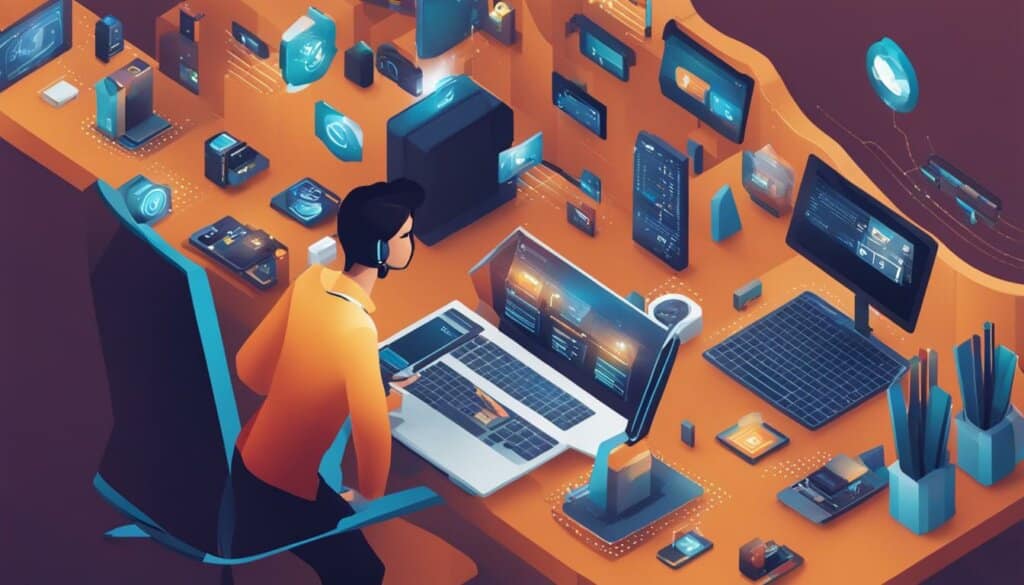
Conclusion
Edge computing offers numerous benefits to small businesses in terms of efficiency, security, and competitiveness. By leveraging edge computing, small businesses can optimize real-time data processing, reduce latency, protect sensitive data locally, and minimize costs. This innovative approach enables small businesses to stay competitive in their respective industries.
The combination of edge computing and cloud computing further enhances the overall technological capabilities of small businesses. By harnessing both edge computing and cloud computing, businesses can achieve a balanced and efficient technology business model. Cloud architects certified in platforms like Microsoft Azure and Amazon Web Services (AWS) are increasingly deploying edge devices to optimize operations.
Implementing edge computing can significantly improve the efficiency and effectiveness of small businesses. It puts data closer to the devices using it, enabling real-time data processing without compromising performance. This proximity reduces latency, allowing for faster access to information. Additionally, edge computing enhances security by managing sensitive data locally, reducing the risk of data breaches and unauthorized access. By adopting edge computing, small businesses can unlock new capabilities and gain a competitive edge in their industries.
FAQ
What is edge computing?
Edge computing is a distributed computing model that allows for faster performance and reduced bandwidth by processing workloads closer to their access location. It involves using edge devices such as IoT sensors, local servers, and end-user devices to provide faster and easier access to information.
What are the benefits of edge computing for small businesses?
Edge computing offers several benefits for small businesses, including improved real-time data processing, reduced latency, enhanced security, and cost optimization. By processing data closer to the edge, businesses can achieve faster performance, reduce bandwidth usage, and optimize costs.
Can you provide any real-world examples of edge computing success?
Certainly! The City of London, a small but bustling financial hub, implemented an edge computing architecture that enabled 70% of personnel to work remotely using mobile devices. This infrastructure allowed for greater productivity and efficiency, with features such as mobile apps, video calls, and digital stock control. The City of London plans to further improve its edge capabilities by integrating IoT devices.
How does edge computing interact with cloud computing?
Edge computing and cloud computing can work together to create a balanced and efficient technology business model. Cloud architects, certified in platforms like Microsoft Azure and Amazon Web Services (AWS), are increasingly deploying edge devices to optimize operations. The combination of cloud processing power and the rapid response of edge devices can enhance efficiency and deliver real-time results.
What is the impact of 5G on edge computing?
5G technology plays a crucial role in the success of edge computing. It provides faster wireless connectivity, reduces latency, and enables higher speeds by placing computational functions closer to the data source. By leveraging the benefits of 5G, edge computing can offer improved reliability, higher processing speeds, and reduced bandwidth requirements and costs.
In which industries can edge computing be applied?
Edge computing has diverse applications across various industries. In healthcare, it can enhance device performance and data management, leading to better patient care. In retail, edge computing enables real-time data analysis, improving customer experiences and optimizing store operations. Manufacturers can leverage edge computing for predictive maintenance and quality control. Agriculture can benefit from improved crop monitoring, while automotive companies can enhance safety and infotainment systems. Energy and utility companies can leverage edge computing for predictive maintenance and real-time performance monitoring.
How does edge computing improve data analytics and security?
Edge computing enhances data analytics by introducing higher levels of intelligence early in the process. This improves the accuracy and speed of analysis, enabling faster decision-making. In terms of security, edge computing provides a more efficient and secure system by isolating devices and reducing bandwidth usage. It also improves operational efficiency by processing data at the edge, eliminating the need for centralized processing and reducing latency.
How does edge computing optimize costs for small businesses?
Edge computing significantly reduces costs for small businesses. By processing data closer to the edge, businesses can reduce the amount of data that needs to be processed in the cloud or centralized location, resulting in cost savings. Additionally, edge computing eliminates the need for excessive data storage by sending only useful information to the cloud for processing. This optimization of data processing and storage helps small businesses minimize their operational costs.
How does edge computing improve user experience?
Edge computing unlocks new capabilities for user experiences, particularly in augmented reality (AR). With edge computing, AR experiences become more vivid, faster, and improved. This opens up opportunities for businesses to transform aspects of their operations and enhance customer engagement. By leveraging the benefits of edge computing, businesses can provide real-time, personalized experiences to their users, leading to increased customer satisfaction and loyalty.
Source Links
- https://www.verizon.com/business/resources/articles/s/benefits-of-edge-computing-for-businesses/
- https://www.simplilearn.com/how-businesses-are-leveraging-edge-computing-for-big-benefit-article
- https://www.forbes.com/sites/forbestechcouncil/2019/12/23/13-ways-edge-computing-can-benefit-businesses/?sh=734dd4a139a8


